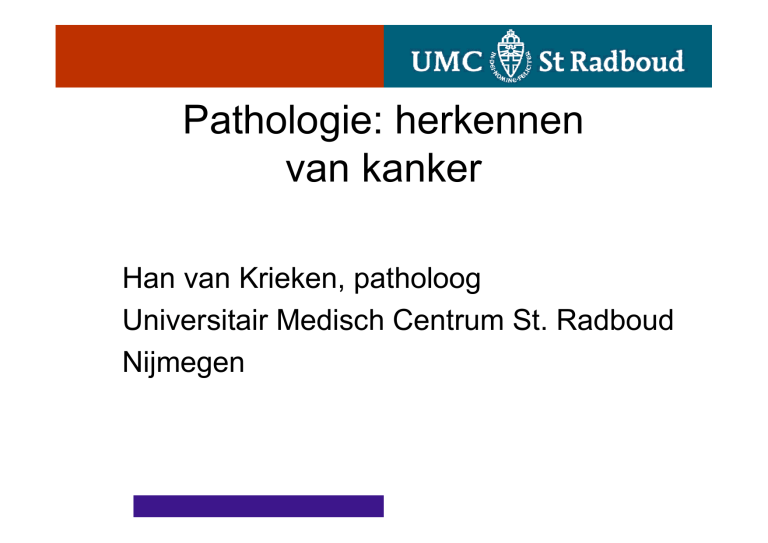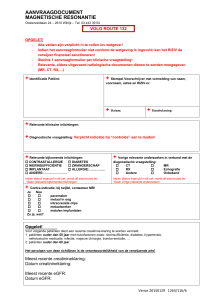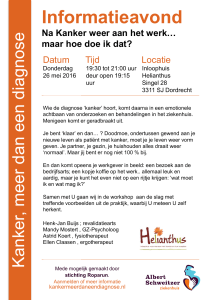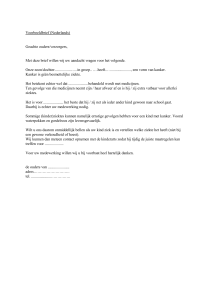
Pathologie: herkennen
van kanker
Han van Krieken, patholoog
Universitair Medisch Centrum St. Radboud
Nijmegen
Pathologie: herkennen
van kanker
• Definitie
• Moleculaire basis
• Morfologie en aanvullende technieken
• Criteria
• Statement
Definitie
Kanker is gedefinieerd als een proces dat
als gevolg van genetische veranderingen
gestoorde groeiregulatie heeft en dat via
invasieve groei en uitzaaiingen kan leiden
tot het overlijden van de patiënt.
Moleculaire basis
• groeicontrole
• apoptose
• genetische instabiliteit
• DNA repair
• matrixdegradatie
• angiogenese
• escape van host respons
Morfologie
• Kanker wordt meestal gediagnostiseerd op
basis van weefselonderzoek door een
patholoog
• Morfologie
• Immuunhistochemie
Macroscopische en
microskopische beoordeling
mesorectum
CRM
distal
margin
mesorectum
CRM
Macroscopie
Compleet mesorectum:
Onverwacht positieve marge
Microscopie
Weinig stromareactie
EGFreceptor blokkade
Colorectal
Lung
Head and Neck
Epidermal Growth Factor Receptor (EGFR) in Colorectal
Cancer
• EGFR can be overexpressed in colorectal cancer
• Tumor cell proliferation and growth can result from
EGFR-mediated signals
• In vitro and in vivo data suggest that preventing the
binding of natural ligands to EGFR may result in
inhibition of tumor cell growth and lead to cancer cell
death
• Monoclonal antibodies can inhibit the binding of
ligands such as EGF, TGF-, and other ligands to
EGFR
Herbst RS, Shin DM. Cancer. 2002;94(5):1593-1611.
EGFR Belongs to the ErbB Family of Cell Surface
Receptors
Extracellular
Domain
Transmembrane
Domain
Intracellular
TK Domain
ErbB3
(HER3)
ErbB1
(EGFR)
ErbB2
(HER2/neu)
ErbB4
(HER4)
EGFR Activation Enhances Pathways Important for Tumor
Cell Growth
EGFR Activation
Tumor
Blood
Vessel
Metastatic
Spread
Angiogenesis
Cell
Survival
Tumor
Blood
Vessel
Proliferation
EGFr- expression: normal, adenoma, carcinoma
EGFr expression: heterogeneity
EGFr expression: heterogeneity
EGFr expression: heterogeneity
EGFr Signal Transduction
Ligand
Ligand
EGFR dimer
Shc
Signal
Adapters
and Enzymes
Grb-2
STAT
P13K
SOS
Raf
Akt
PTEN
Ras
MEK 1/2
mTOR
Transcription
Factors
FKHR
GSK-3
MAPK
p27
Jun
FOS Myc
BAD
Cyclin D-1
Signal
Cascade
KRAS Is Important in Growth and Cell Division—
Mutations Can Cause Cancer
inactive
GDP
Normal:
– Growth
– Proliferation
– Differentiation
active
GTP
inactive
GDP
active
*
GTP
• Ras proteins are
GTPases
• Ras family members
include: KRAS, NRAS,
and HRAS
Normal cycle occurs
between a GDP-bound
(inactive) and a GTPbound (active) form of
Ras
Specific mutations in the
Schubbert
S, et al.gene
Nature Rev
Cancer. in a
KRAS
result
2007;7:295-308.
constitutively active
protein
•
ABNORMAL:
– Growth
– Proliferation
– Differentiation
•
KRAS mutations in colorectal cancer:
tested: 10624, mutation: 3603 (34%)
Single-Arm Studies Support the Hypothesis for KRAS as
a Biomarker for EGFr Inhibitors
Objective
Response
N (%)
Treatment
(panitumumab or cetuximab)
No of patients
(WT:MT)
MT
WT
cmab ± CT
76 (49:27)
0 (0)
24 (49)
S. Benvenuti, et al.
(Cancer Res, 2007)
pmab or cmab or cmab + CT
48 (32:16)
1 (6)
10 (31)
W. De Roock, et al.
(ASCO Proceedings, 2007)
cmab or cmab + irinotecan
113 (67:46)
0 (0)
27 (40)
D. Finocchiaro, et al.
(ASCO Proceedings, 2007)
cmab ± CT
81 (49:32)
2 (6)
13 (26)
F. Di Fiore, et al.
(Br J Cancer, 2007)
cmab + CT
59 (43:16)
0 (0)
12 (28)
S. Khambata-Ford, et al.
cmab
80 (50:30)
WT,
wild Oncol,
type; MT,2007)
mutant; cmab, cetuximab; CT, chemotherapy; pmab, panitumumab
(J
Clin
0 (0)
5 (10)
Reference
A. Liévre, et al.
(AACR Proceedings, 2007)
Practical issues
• KRAS mutational analysis feasible on formalin fixed,
paraffin embedded tissue
• Sensitivity in colorectal cancer not an issue
• Hot spots for mutations Codons 12 and 13 (to a
lesser extend 61 in lung cancer)
• Several methods
• Sequencing
• Real-time PCR
• Newer methods
• Quality assurance
• Costs
ER
HER2
KIT
EGFR
HER-2 amplified breast carcinoma
Criteria
• belangrijkste biologische criterium: uitzaaiing,
•
metastase (vrijwel nooit doorslaggevend voor
de patholoog)
afgeleide criteria:
- (solide tumoren) invasieve groei
- cellulaire veranderingen (cel- en
kernpolymorfie, atypie)
- veranderde architectuur (cribriforme of
solide groei)
Criteria, vervolg
Uitzonderingen: carcinoid
Problemen ‘low malignant potential’,
‘borderline’, ‘atypisch’ of ‘tumor’
Conclusie: ga niet alleen op de naam van
een proces af, maar ga na welke ziekteentiteit door een bepaalde diagnose
wordt gerepresenteerd.
Meer problemen
Voorspellen/ behandeling
Grijs gebied
Toetsbaar
Conclusie: de grens tussen goed- en
kwaadaardig is niet scherp, de voorspelling
is niet absoluut.
Meer problemen: Sampling
Klein biopt
Tumoren zijn vaak heterogeen
Conclusie: als de pathologische diagnose
onverwacht is, niet past bij het klinische
vermoeden, denk dan altijd aan de mogelijkheid
van sampling error.
Nog meer problemen:
Definiëren
Definities veranderen
Voorbeeld: MALT-lyfoom van de maag
Extranodaal marginale zone lymfoom
• Primair maag lymfoom large cell
• Pseudolyfoom
small cell
• Clonaliteit, MALT-lymfoom small/large
• Rol Helicobacter pylori
• Marginale zone lymfoom small cell
• Extranodaal marginale zone lymfoom
Conclusie
De diagnostiek beweegt zich in de richting van
het definiëren van ziekte entiteiten en het
bijhorend klinisch-pathologisch spectrum. Een
simpele indeling kanker versus niet kanker kent
de natuur niet.
Case history
•Female (13-09-46)
•1994: histologically proven celiac disease
•2000: in spite of diet return of symptoms
•
biopsy 00-13423: histology almost normal
no treatment
•
•2001: twice new biopsies
Further studies
• Flow-cytometry (April 2001): loss of surface
CD3
• Southern-blotting: the same clonal result for
TCR in submitted biopsy and in September
2001
Summary & Diagnosis
• Ongoing clinical deterioration
• Histology normal
• Aberrant phenotype
• Persistent clone
• High risk refractory celiac disease
Clonality analysis in celiac
disease (Biomed 2 primers)
• Clonal results in:
• Enteropathy associated T-cell NHL
• Refractory celiac disease
• Untreated celiac disease
• Dyspepsia, diarrhoea
4/4
10/18
4/10
3/9
Conclusion
• Histology alone is not sufficient
• Clonality analysis needs to be interpreted with
care and in the right clinicopathologic setting
• Treatment in controlled trial
Statement: Refractaire coeliakie is
een vorm van kanker
Patiënten met coeliakie:verhoogd risico op T-cel lymfomen.
Dit zijn agressieve lymfomen waartegen geen behandeling
mogelijk is en waaraan patiënten meestal binnen enkele
maanden overlijden.
Er komt bij patiënten met coeliakie ook een situatie voor waar
zij niet meer reageren op dieettherapie: refractaire coeliakie.
Morfologisch is er dan niet veel te zien. Met technieken als
flow-cytometrie en moleculaire biologie kan een aberrante Tcel populatie worden gevonden, een echt lymfoom kan de
patholoog morfologisch niet diagnosticeren.
De meerderheid van de patiënten in deze situatie ontwikkelt
later een lymfoom.












